en
names in breadcrumbs


There are three subspecies of Sylvilagus nuttallii: S. nuttallii grangeri, S. nuttallii nuttallii, S. nuttallii pinetis. Another common name of this animal is Nuttall’s cottontail. (Chapman, 1999)
Perception Channels: tactile ; chemical
The mountain cottontail is common in its geographic range but has rapidly declined in western North Dakota. (Chapman, 1999)
US Federal List: no special status
CITES: no special status
IUCN Red List of Threatened Species: least concern
They graze on grasses until the area is depleted, which can cause habitat change.
Their droppings serve as fertilizer and the rabbits are potentially food for endangered species of carnivorous birds, mammals, and snakes. Like other cottontails, the mountain cottontail is valued by humans for its beauty and grace.
Positive Impacts: food ; body parts are source of valuable material
This cottontail eats the grass on mountainsides and keeps the vegetation sparse.
Parasites include nematodes and cestodes.
The rabbit feeds near water, in the cover of brush, or in the open near brush cover. Heavy wind and rain can reduce the likelihood that the animal will eat in the open. (Chapman, 1975) (Verts & Gehman, 1991)
Mountain cottontail prefer grasses when they are available above other food sources, but when grasses are sparse major foods are sagebrush, Western Juniper and the juniper berries. (Enature, online)
Plant Foods: leaves; fruit
Primary Diet: herbivore (Folivore , Lignivore); coprophage
The mountain cottontail lives mostly in the western part of the United States. Its range is bordered in the east by Montana’s eastern border, in the west by the Sierra Nevada Mountains, in the south by the middle of New Mexico and Arizona, and in the north by the US/Canadian border; however a small area of Canada right above Montana and Washington is also included. (Chapman, 1975)
Biogeographic Regions: nearctic (Native )
The cottontail inhabits brushy or wooded areas on slopes or riverbanks that are often covered with grasses, willows, and most importantly, sagebrush. If vegetation is sparse, as on a rocky mountainside, these rabbits can hide in burrows or rock crevices. (Chapman, 1975) (Sibr, online)
Habitat Regions: terrestrial
Terrestrial Biomes: forest ; scrub forest ; mountains
Range lifespan
Status: captivity: 7.4 (high) years.
The mountain cottontail is of medium to large size for its genus with long hind legs and a large tail that is dark on top and light below. The top of the body is covered in grayish brown fur, and the underbelly is white. The hind legs are covered with reddish brown hairs that are long and dense. The ears are rather short and rounded. They have black tips and long hairs on their inner surfaces. The animal's whiskers are usually white. The females have eight to ten mammae. In this species there is a single annual molt. The rabbits weigh between 0.7 kg and 1.2 kg and are between 35 cm and 39 cm in body length. Females are nearly five percent larger than males.
Skull characteristics of Sylvilagus nuttallii include a long rostrum, small supraorbital processes, and long and slender postorbital processes. The animal also has a rounded braincase, and a dental formula of 2/1, 0/0, 3/2, 3/3 with rather large molariform teeth.
(Chapman, 1975) (Chapman, 1999) (Enature, online) (Schneider, 1990)
Range mass: 0.7 to 1.2 kg.
Range length: 35 to 39 cm.
Other Physical Features: endothermic ; bilateral symmetry
The only antipredation techniques reported are rapidly running to a safe sheltered area and restricting activity to dusk and dawn.
(Chapman, 1975) (Bull, 2000) (Sibr, online)
Mammalian predators include coyotes, bobcats, and martens. Other predators include hawks, eagles, owls, and rattlesnakes.
Known Predators:
These cottontails are normally solitary unless the habitat can support more than one animal. The animals mate between March and July and almost always at night. They do not form pair bonds. (Chapman, 1975) (Schneider, 1990) (Verts & Gehman, 1991)
Breeding season: March-July
Range number of offspring: 1 to 8.
Average number of offspring: 5.
Range gestation period: 28 to 30 days.
Range weaning age: 28 (high) days.
Range age at sexual or reproductive maturity (female): 90 (low) days.
Range age at sexual or reproductive maturity (male): 90 (low) days.
Key Reproductive Features: gonochoric/gonochoristic/dioecious (sexes separate); sexual ; fertilization (Internal ); viviparous
Average number of offspring: 3.6.
Before the female gives birth she makes a nest that is shaped like a cup and lines it with grass, fur, and sticks. The young are altricial with no hair, and they are blind. (Schneider, 1990) (Sibr, online)
Parental Investment: altricial